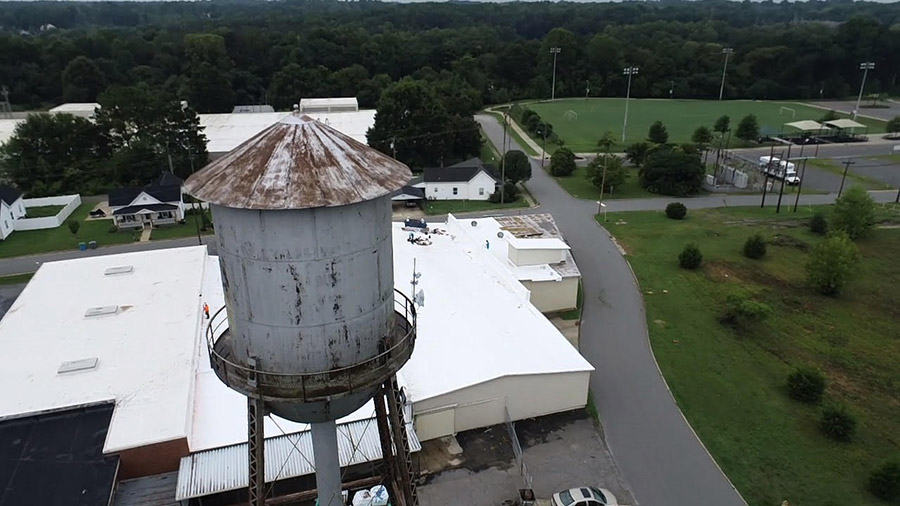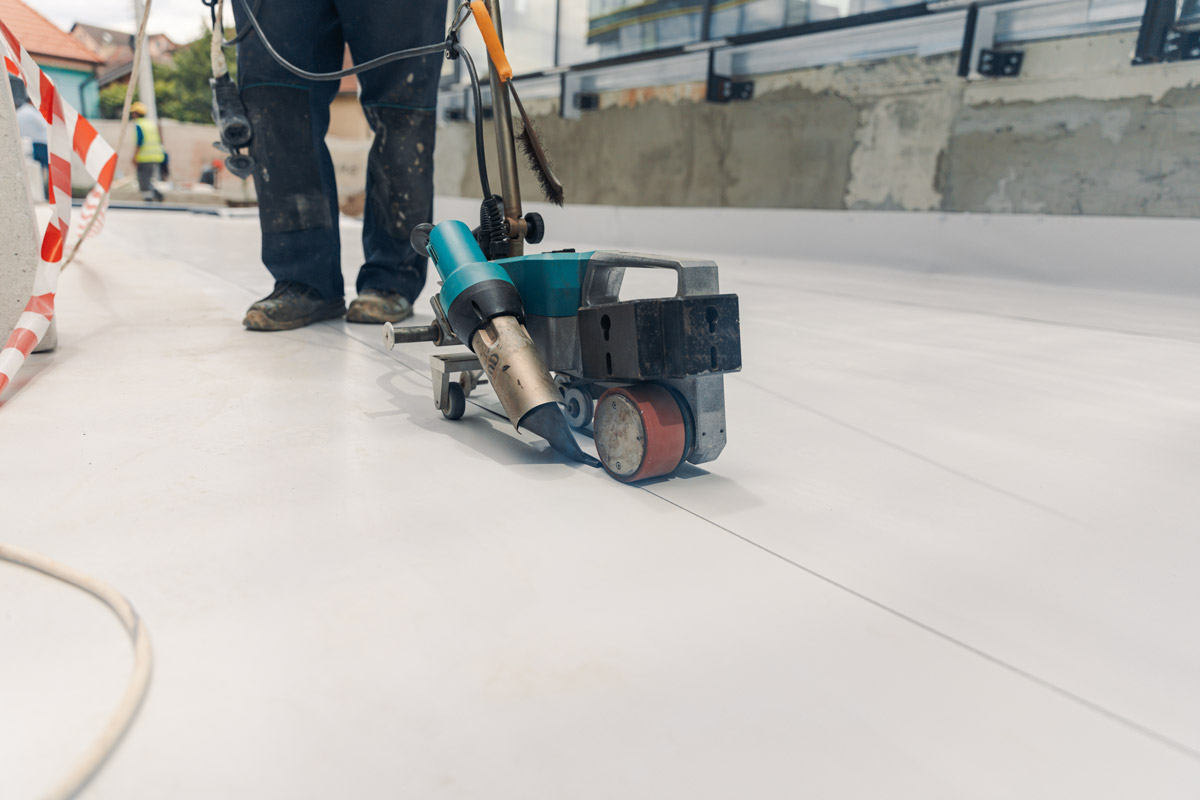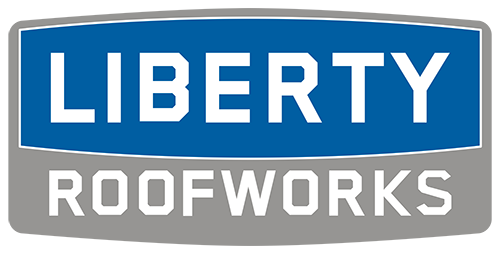Everything You Need to Know About PVC Roofs for Durable Roofing Solutions
Are you looking for a durable and reliable roofing solution? PVC roofs have recently gained popularity due to their superior protection and durability. In this blog, we’ll discuss everything you need to know about PVC roofs, including their advantages, different types, installation, maintenance, repairs, and cost.
We’ll also compare PVC roofs with TPO and answer some of the most common questions about PVC roofs. Let’s get started.

Contact Us Today
Have skilled roofers at Liberty Roofworks provide you with roofing services in Columbia, SC. We provide a free roof inspection and estimate for your convenience.
Liberty Roofworks
1397 Cilantro Ct.,
Tega Cay SC 29708
Monday-Friday | 8am-5pm
(704) 463-8177
Introduction to PVC Roofs
PVC roofing is a type of roofing membrane made from polyvinyl chloride (PVC). It is a single-ply membrane that’s lightweight, strong, and highly resistant to fire, ultraviolet (UV) radiation, and extreme weather conditions. Moreover, PVC roofs are increasingly becoming the preferred choice for commercial and industrial buildings due to their superior protection and durability.
Advantages of PVC Roofs
The many advantages of PVC roofs make them an excellent choice for commercial and industrial buildings. Here are some of the most notable benefits of PVC roofs:
- PVC roofs are highly durable and can last up to 30 years with proper maintenance.
- They are highly resistant to fire, UV radiation, and extreme weather conditions.
- This type of roof is lightweight and easy to install.
- The PVC roof is energy-efficient and can reflect up to 85% of the sun’s rays, which can help reduce energy costs.
- Also, they are low-maintenance and easy to repair.
Different Types of PVC Roofs
There are several different types of PVC roofs available. Here are some of the most common ones:
Standard PVC Roof Membrane
The standard PVC roofing membrane is a single-ply product. Business-leading PVC membrane roof products are Energy Star-approved and designed to provide long-term water damage protection and heat reflection.
This PVC roofing system usually has polyester in the middle of two membrane layers for reinforcement. Additives improve flexibility, and standard PVC is typically placed with adhesives or fasteners.
KEE PVC Roof Membrane
When manufacturing PVC roof membrane materials, rigid parts must be adjusted to make each more flexible. As time passes, the liquid plasticizers needed to make this happen may evaporate, which is why KEE (Ketone Ethylene Ester) was developed. The concentrated polymer component used in KEE PVC membrane roofing materials outperforms several liquid plasticizers.
A PVC KEE membrane keeps its flexibility longer and increases the life of a roof. This type of PVC membrane roofing material is also usable in combination with asphalt and effectively reflects direct sunlight over time.
PVC Roof Membrane – Fleece Backed
It supports a reduced or flat roof by connecting high-quality fleece pieces to the PVC membrane’s bottom. Because they may be spread out straight on the rooftop, fleece-inclusive products are easy to install.
This method saves money on labor while providing an efficient defensive PVC roofing layer. Furthermore, a PVC roof system that uses fleece-backed materials can be fixed with adhesives or fasteners.
PVC Roof Installation
PVC roofs are relatively easy to install and can be done by any professional roofer. The installation typically involves attaching the roof to the building with a roofing adhesive, followed by sealing the edges with a waterproof sealant. It is essential to hire a professional roofer to ensure that the roof is installed correctly and to avoid any potential problems.
PVC Roof Maintenance
These PVC roofs are low-maintenance and require very little upkeep. Generally, all that is needed is an annual inspection and cleaning to remove debris or dirt. It is essential to inspect the roof for any damage or wear and tear and to make any necessary repairs to ensure the top is in good condition.
PVC Roof Repairs
Inspecting the roof regularly and making necessary repairs to ensure the top is in good condition. PVC roofs are relatively easy to repair, and any professional roofer can do it. Generally, all that is required is to seal any holes or cracks with a waterproof sealant and to replace any damaged or worn-out parts.
Cost of PVC Roofs
Generally, PVC roofs cost more than other types of roofs, but they are also more durable and long-lasting. The cost of PVC roofs varies depending on the size and complexity of the project. Likewise, the total cost will also depend on the type of PVC roof and the installation and maintenance costs.
However, the most critical information concerning the PVC roofing membrane is arguably the most crucial for homeowners. Of course, this is the amount it will cost you.
Budget between $14.00 to $17.00 per sq. foot for a PVC roofing membrane on smaller projects and about $12.00 per sq. foot for bigger ones. Consider that the cost of a roof is determined by various factors, making an exact estimate impossible to provide.
Furthermore, the kind of insulation used beneath your PVC roofing membrane is a significant cost issue. Using thick enough insulation to cover the entire structure would cost more than applying fabric insulation and adding the membrane with glue.
Another important consideration is the dimensions of the roof obtaining the PVC membrane. The cost per sq. foot will be at the upper end of the specified price range on smaller projects.
However, the cost per sq. foot drops when it comes to larger roofing jobs.
Why Do You Need a PVC Roofing Membrane?
The first thing homeowners need to know about PVC roofing membranes is why they need them and how they would use them. When your roof has a pitch below 2:12, it’s considered a low slope.
Furthermore, the issue is that water does not run off as quickly on a flat roof or low slope as it does on a high pitch. As a result, it requires a waterproof roof material.
This requirement eliminates many roofing materials, particularly asphalt shingles, since they can’t withstand standing water. According to the shingle dealership’s installation guidelines and building requirements, asphalt shingles should not be on a rooftop pitch of less than 2:12.
As a result, flat roofs or low slopes must have a PVC roofing membrane.

What’s the Lifespan of a PVC Roofing Membrane?
A roof’s lifespan determines the return on investment and enables you to predict when you’ll need to replace it in the future. The PVC roofing membrane can last for around 25 years if correctly placed.
While giving a PVC roofing membrane 25 years is excellent, that doesn’t necessarily mean it’ll live that long. Various factors determine a roof’s lifespan (including PVC).
These elements include the climate, the amount of direct sunshine that reaches it, and the installation efficiency. However, if the roofers properly install your PVC roofing membrane, it should last as long as possible.
Proper installation is among the most significant benefits of this kind of roofing. It can save you a lot of money on costly maintenance and repairs. Furthermore, proper maintenance can extend the life of your PVC rooftop, for instance:
- The most critical component in extending the life of the PVC roof is proper drainage, which includes preventing standing water because this is a frequent issue with flat rooftops.
- Inspecting gaps and seams after a storm is another vital component of maintaining the PVC roofing membrane.
- Checking for any worn areas or damage before a leak appears to ensure that the roof covering duration is not reducing and no additional harm occurs.
TPO vs. PVC Roofing
TPO and PVC are two of the most common types of roofing materials. Both materials are highly durable, fire-resistant, and long-lasting. TPO is typically less expensive than PVC but is less durable or long-lasting than PVC. On the other hand, PVC is more resistant to UV radiation and extreme weather conditions and is generally more expensive than TPO.
PVC and TPO are usable in commercial, industrial, or institutional roofing applications. However, knowing each material’s distinct benefits and drawbacks is vital when deciding between the two. Furthermore, once you’ve selected, you should seek a reliable and experienced supplier to guarantee you get a high-quality product.
Frequently Asked Questions about PVC Roofing
Here are some of the most commonly asked questions about PVC roofs:
How Long Do PVC Roofs Last?
PVC roofs can last up to 25 years with proper maintenance.
Are PVC Roofs Energy-efficient?
Yes, PVC roofs can reflect up to 85% of the sun’s rays, which can help reduce energy costs.
How Much Do PVC Roofs Cost?
The cost of PVC roofs varies depending on the size and complexity of the project. Generally, PVC roofs cost more than other types of roofs, but they are also more durable and long-lasting.
Are PVC Roofs Challenging to Install?
No, PVC roofs are relatively easy to install, and your nearby expert roofer can do it quickly.
PVC roofs are an excellent choice for commercial and industrial buildings due to their superior protection and durability. They are highly resistant to fire, UV radiation, and extreme weather conditions and are also energy-efficient and low-maintenance.
The cost of PVC roofs varies depending on the size and complexity of the project, but they are generally more expensive than other types of roofs. If you have any questions about PVC roofs in Columbia, SC, call us to get expert help.
